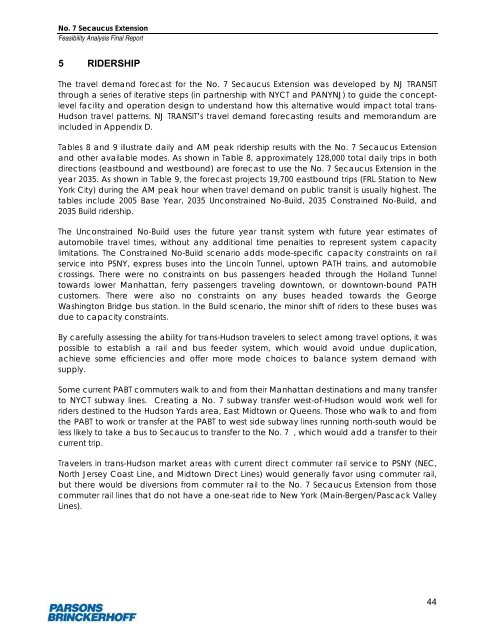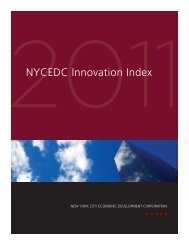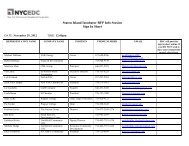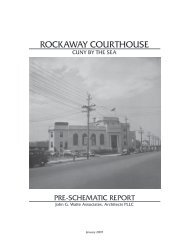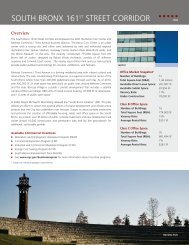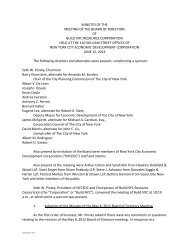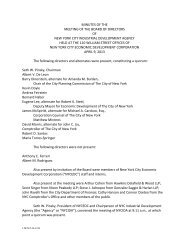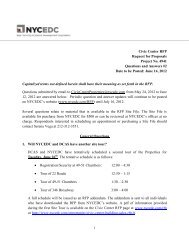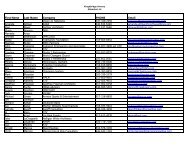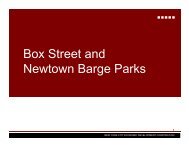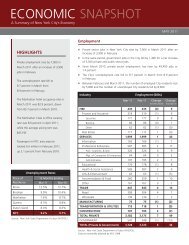No 7 Secaucus Extension Final Report - NYCEDC
No 7 Secaucus Extension Final Report - NYCEDC
No 7 Secaucus Extension Final Report - NYCEDC
Create successful ePaper yourself
Turn your PDF publications into a flip-book with our unique Google optimized e-Paper software.
<strong>No</strong>. 7 <strong>Secaucus</strong> <strong>Extension</strong>Feasibility Analysis <strong>Final</strong> <strong>Report</strong>5 RIDERSHIPThe travel demand forecast for the <strong>No</strong>. 7 <strong>Secaucus</strong> <strong>Extension</strong> was developed by NJ TRANSITthrough a series of iterative steps (in partnership with NYCT and PANYNJ) to guide the conceptlevelfacility and operation design to understand how this alternative would impact total trans-Hudson travel patterns. NJ TRANSIT’s travel demand forecasting results and memorandum areincluded in Appendix D.Tables 8 and 9 illustrate daily and AM peak ridership results with the <strong>No</strong>. 7 <strong>Secaucus</strong> <strong>Extension</strong>and other available modes. As shown in Table 8, approximately 128,000 total daily trips in bothdirections (eastbound and westbound) are forecast to use the <strong>No</strong>. 7 <strong>Secaucus</strong> <strong>Extension</strong> in theyear 2035. As shown in Table 9, the forecast projects 19,700 eastbound trips (FRL Station to NewYork City) during the AM peak hour when travel demand on public transit is usually highest. Thetables include 2005 Base Year, 2035 Unconstrained <strong>No</strong>-Build, 2035 Constrained <strong>No</strong>-Build, and2035 Build ridership.The Unconstrained <strong>No</strong>-Build uses the future year transit system with future year estimates ofautomobile travel times, without any additional time penalties to represent system capacitylimitations. The Constrained <strong>No</strong>-Build scenario adds mode-specific capacity constraints on railservice into PSNY, express buses into the Lincoln Tunnel, uptown PATH trains, and automobilecrossings. There were no constraints on bus passengers headed through the Holland Tunneltowards lower Manhattan, ferry passengers traveling downtown, or downtown-bound PATHcustomers. There were also no constraints on any buses headed towards the GeorgeWashington Bridge bus station. In the Build scenario, the minor shift of riders to these buses wasdue to capacity constraints.By carefully assessing the ability for trans-Hudson travelers to select among travel options, it waspossible to establish a rail and bus feeder system, which would avoid undue duplication,achieve some efficiencies and offer more mode choices to balance system demand withsupply.Some current PABT commuters walk to and from their Manhattan destinations and many transferto NYCT subway lines. Creating a <strong>No</strong>. 7 subway transfer west-of-Hudson would work well forriders destined to the Hudson Yards area, East Midtown or Queens. Those who walk to and fromthe PABT to work or transfer at the PABT to west side subway lines running north-south would beless likely to take a bus to <strong>Secaucus</strong> to transfer to the <strong>No</strong>. 7 , which would add a transfer to theircurrent trip.Travelers in trans-Hudson market areas with current direct commuter rail service to PSNY (NEC,<strong>No</strong>rth Jersey Coast Line, and Midtown Direct Lines) would generally favor using commuter rail,but there would be diversions from commuter rail to the <strong>No</strong>. 7 <strong>Secaucus</strong> <strong>Extension</strong> from thosecommuter rail lines that do not have a one-seat ride to New York (Main-Bergen/Pascack ValleyLines).44


